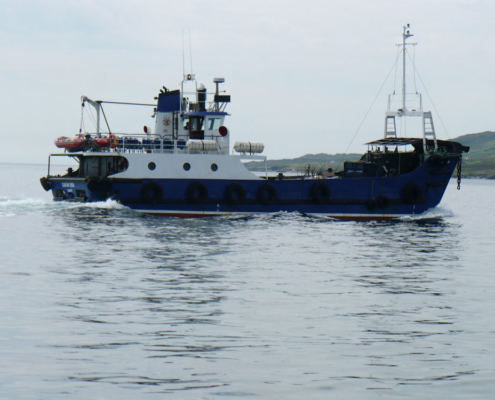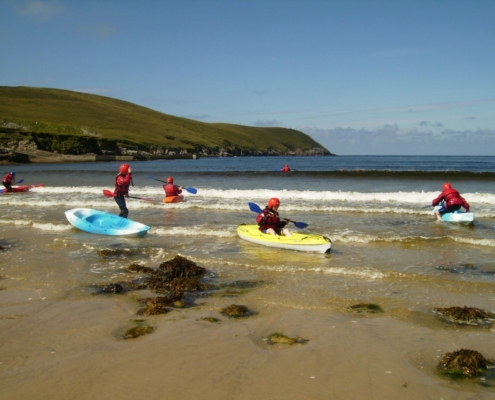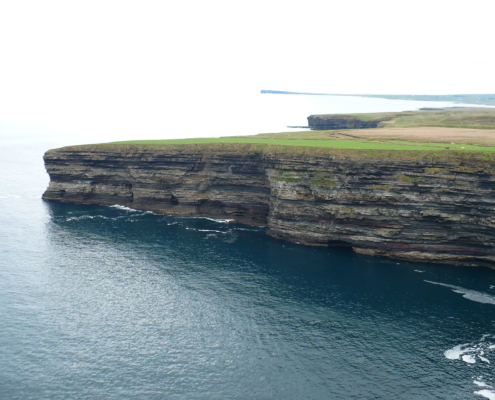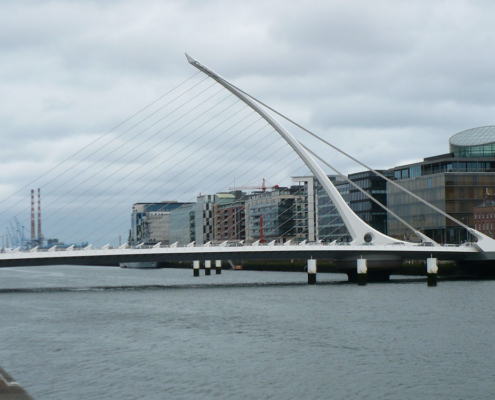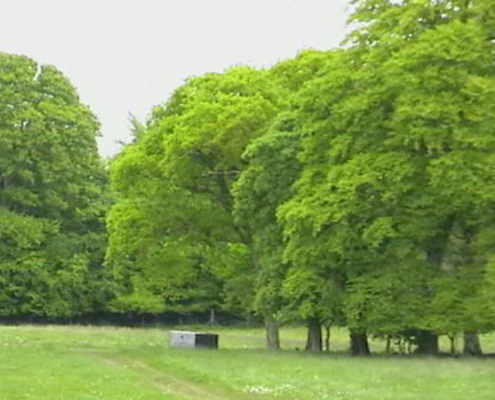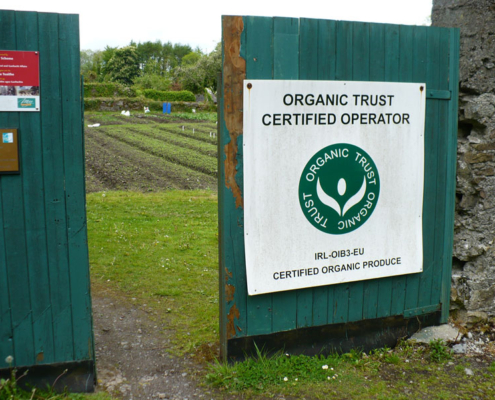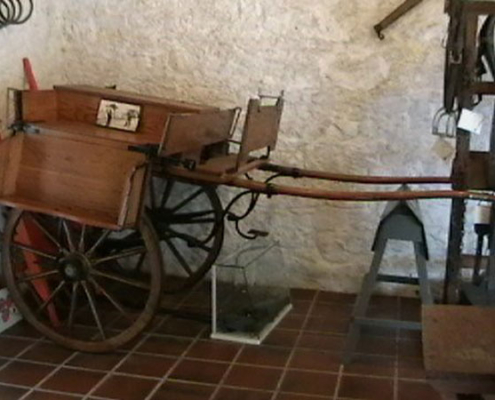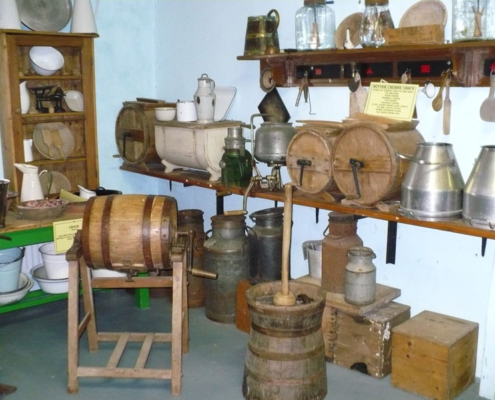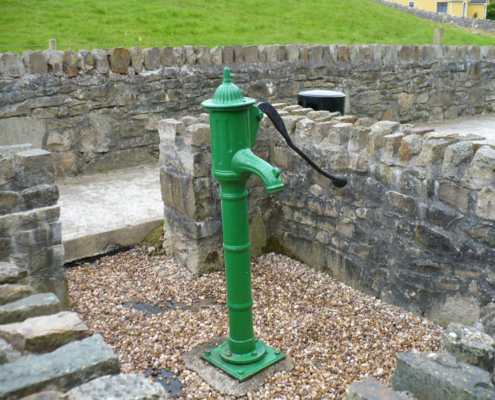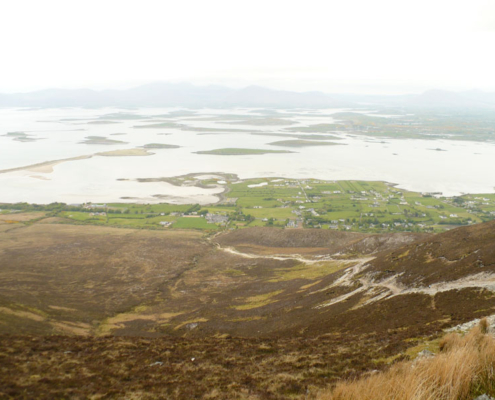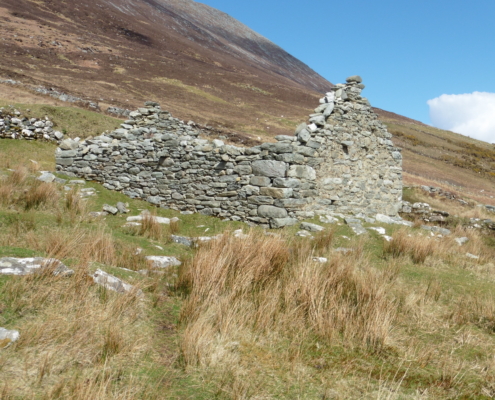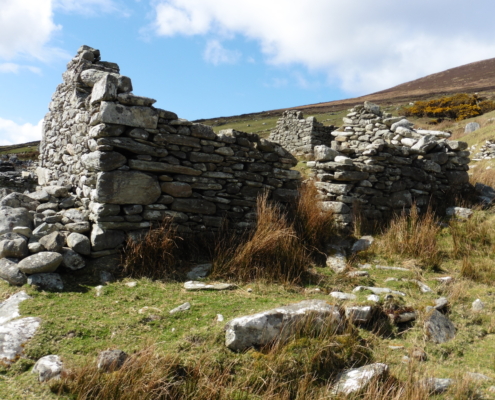Overview
On our Ecotour in Mayo, in Northwest Ireland, visitors will see a land of nature undisturbed. Importantly, the guardians both of a natural habitat and of our national Irish (or Gaelic) culture, will welcome those who come. French, German and Gaelic people had close connections in times gone by, as shown in our video 2 and video 3. Celtic households boast of a 3,000 year-old culture (please visit our videos collection), which stretches back unbroken to the last Ice Age. Our common heritage goes back to when all Europe was covered by forests and the fragile beauty of the Earth was unchallenged. The awesome wonder of a pristine landscape awaits our visitors. They will walk, as man once did, in his natural surrounding. They will see the marks of human habitation – from one, two, five thousand years ago. They will stay in the houses of people who have wanted them to come. By travelling here, visitors will enjoy an unforgettable holiday. We hope they will want their children to cherish the countryside, as they have seen it.
Special Ecotour Features
Guides will speak French or German, for the ease of visitors and to emphasise cultural connections to Gaelic people, explained elsewhere on this website. As it were travelling back in time, visitors will hear the Celtic Irish language in households where they stay. The closest of all Celtic languages, to that heard in ancient Germania and Gaul, is Irish. Mná Tí (Ladies of the House), provide accommodation in households, in which Irish is the language of communication, between family members of all ages. The cultural experience of visitors is at the heart of the Ecotour. There is a questionnaire, for comments, after the Ecotour. The remote areas to be visited are not generally for people, unfamiliar with the landscape, to explore on their own. There will, all the same, be no shortage of engagement for visitors. Volunteers from many countries run our Company. A Strategic Partner operates the Ecotour for French- and German-speaking visitors, under contract. Our aims include: i) rebuilding, at the level of the ordinary person, Gaelic Ireland’s connections to France and Germany, too long interrupted; ii) promulgation of information about the environment (our Ecomessage refers); iii) highlighting the value and beauty of the Irish, French and German cultures; and iv) facilitating the best holiday ever for visitors. An Ecotour, properly defined, requires that a community in danger benefit: Irish-speaking communities are so placed, in danger of succumbing to modern pressures. Celtic culture was once an anchor culture in Europe. It has been projected that, ultimately, five languages will survive in the global arena.
Itinerary
| Day 1: |
– Arrival at Dublin – Ceathrú Thaidhg |
| Day 2: |
– Enniscoe House – Kilasser |
| Day 3: |
– Ballycroy National Park – Croagh Patrick – Clare Island |
| Day 4: |
– Oileán Acla – Heinrich Böll |
| Day 5: |
– The Céide Fields – Ruins of Moyne Monastery – Dún Pádraig – Gaelic Ways |
| Day 6: |
– Kiltimagh (Railway Station) |
Gallery
Day 1 – Arrival at Dublin: Ceathrú Thaidhg
Arrival at Dublin
 Having made earlier connections to your flight to Dublin, you will touch down in the capital before noon. Once in the city centre, you will be welcomed with a drink and a few words on the adventures to come.
Having made earlier connections to your flight to Dublin, you will touch down in the capital before noon. Once in the city centre, you will be welcomed with a drink and a few words on the adventures to come.
The Vikings and, later, the Normans preferred the Irish name Dubh Linn (black pool) for the CapitalCity. However, the Irish preferred the name Baile Átha Cliath (the town of the wattle ford). Both names are still commonly used.
You will have a pass to see the world-famous Book of Kells, in TrinityCollege. This is a copy of the New Testament, in Latin. It was handwritten in Irish majuscule, on some 680 pages of thick vellum, around 800 A.D.
The book is known for the extraordinary intricacy of the illuminating Celtic art. Coloured inks were sourced from as far away as Afghanistan, at the time. It is believed that the work was carried out by two monks, who surely wished that the splendour of Heaven be seen in the manuscript which they produced.
Following a brief meal, you will walk to the nearby Dublinia Exhibition of Viking and mediæval Dublin, for which a pass is also provided. The city was an independent Norse statelet up to 999 A.D. You can visit a Viking house and you can see what life was like on board a Viking warship. An interactive archaeology room shows excavations conducted on the nearby Viking Wood Quay site. You can see a wealthy merchant’s house, as you walk through a mediæval street.
 Ceathrú Thaidhg: Home of the Gaelic Community of Mayo
Ceathrú Thaidhg: Home of the Gaelic Community of Mayo
You will travel, in the evening, to Ceathrú Thaidhg, the high point of the ‘Real Ireland’ experience: an historical meeting of cultures, which have not met as such for centuries.
The Irish word ’Gaeltacht’ means ’the homeland of the Gael’. This once included all of Ireland, Scotland and the Isle of Man.
Accomodation/Dinner will be with Irish-speaking families/individuals or with a local German family, which runs a superb hostel. Family accommodation is clean and comfortable. The standard is that of rural Irish families themselves: part of the Real Ireland experience.
Day 2 – Enniscoe House: Kilasser: Historic Gaelic Welcome
Enniscoe House
 Going south, visitors will go to Enniscoe House. The Old Irish name ‘Áras Inis Cua’ means ‘House of the Island with the Footpath’.
Going south, visitors will go to Enniscoe House. The Old Irish name ‘Áras Inis Cua’ means ‘House of the Island with the Footpath’.
The House is owned by the same family, since before the Famine. It is the last of the mansions of Anglo-Irish landlords in Mayo (called ‘Big Houses’ in Mayo and elsewhere). There is a Family Heritage Centre on the grounds.
In a beautifully maintained Victorian walled garden, you will see the organic vegetables produced by local enthusiasts, encouraged by the present owners.

Kilasser – Poverty and Sufficiency
In the afternoon, you will take a page out of history and have a glimpse at the past when they go to see Hennigan’s Heritage Centre, Kilasser, Swinford, Co Mayo.
Mr Tom Hennigan lives beside the remote 2-room cottage, wherein he was born. He has restored it, with loving care, to how it used to be.
Tom describes the grinding poverty of his people, in years gone by, and how they wrested a livelihood from their land. The small cottage was their home from around 1870, after the Irish potato Famine, until 1970.
Until the 1980s, the family had 10 milch cows and 250 pigs, on the 4-hectare holding. However, subsistence farming, as a way of life, has become less and less possible in the modern world.
 Ceathrú Thaidhg – an historic Gaelic Welcome
Ceathrú Thaidhg – an historic Gaelic Welcome
Later, in the Seanscoil (or ‘Old School’, now a Community Centre), the Gaelic people of Ceathrú Thaidhg will invite you to experience Celtic Culture – which is thriving, even if a little difficult to come by.
On behalf of the people, the Guide will deliver a special, historic Welcome. It emphasizes our ties of friendship which have been forgotten for too long. The focus is on periods of historic importance to both our countries.
Visitors will enjoy a session of ‘Craic agus Ceol’ – ‘fun and music’ – in the centre. Tea, coffee and cakes will be provided free of charge.
The Guide will draw attention to two significant connections to France and Germany, which the people here hold especially dear.
Firstly, the French General Humbert founded the Napoleonic Republic of Connacht (the western province) in 1798, during the long English occupation of the lands of Banba. John Moore was declared president. In great numbers, the young men of Ceathrú Thaidhg served under this French General. The State did not last very long. General Humbert, however, has been highly respected in the region ever since.
Secondly, the Schottenkloster in Ratisbon (it is now called Regensburg and has a Unesco World Heritage Site designation), was built around 1070 AD. It was a significant European institution, teaching eg Philosophy, Law, Mathematics, Theology, Architecture, Economics, History and Politics. It was run by monks such as would have come from the now-ruined monasteries near Ceathrú Thaidhg.
In the name of all those great people who went before us, visitors will, as the event draws to a close, be offered citizenship of the reinvoked Napoleonic Republic of Connacht and an Honarary Doctorate in Philosophy from the Schottenkloster in Ratisbon.
Day 3 – Ballycroy National Park: Croagh Patrick: Island Castle of Queen Gráinne Uí Mháille
Ballycroy National Park – Nature undisturbed
You will visit the Ballycroy National Park. It covers 11,000 hectares of Atlantic blanket bog and a mountainous, uninhabited and untouched wilderness, dominated by Nephin Beg mountain.
The Scardaun Loughs lie between the Nephin and Carr mountains, which latter rises to 721 m above sea-level.
Stroll through the old town of Westport, before having a meal in Matt Molloy’s Public House – with traditional musical entertainment. Matt is a member of the internationally famous traditional music group called ‘The Chieftains‘.

Croagh Patrick – Heaven and Earth combine
The climb to the summit begins from the main road. Pilgrimage here dates back thousands of years, to pagan times. The tradition was maintained, unbroken, after the introduction of Christianity. There are spectacular views of Clew Bay from the pilgrims’ path. Some local people do the climb every week.
On the other side of the main road stands the national monument to the Great Famine (1845-7 AD).
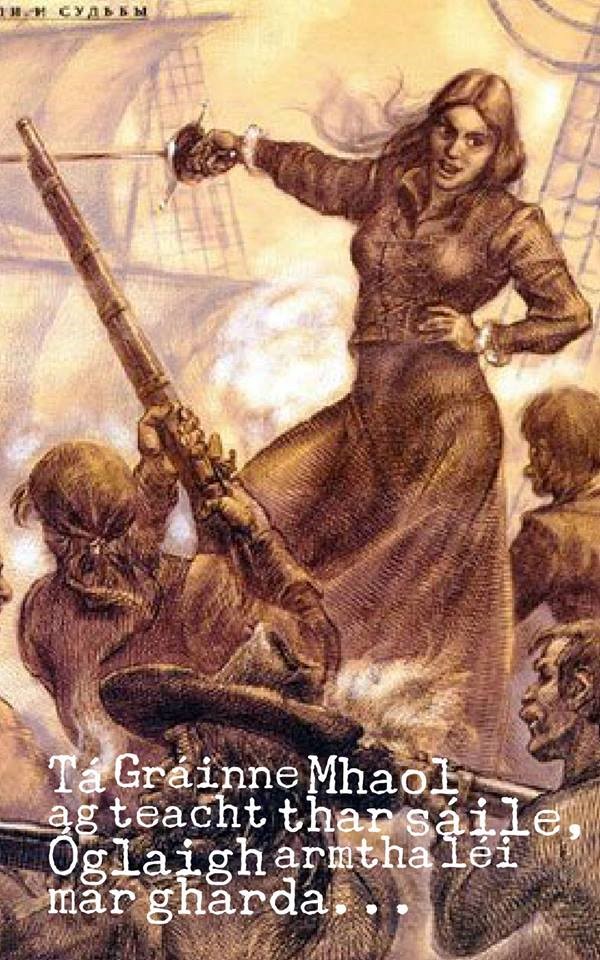 Clare Island and the Castle of Queen Gráinne Uí Mháille
Clare Island and the Castle of Queen Gráinne Uí Mháille
Finally arriving by ferryboat to Clare Island, visitors will see one of the fortresses of the 16th century Queen, Grainne Uí Mháille. She was born in 1530 into the O’Malley Clan. This Clan is strong to this day along the western seaboard.
To Irish historians of the period, Gráinne was unexceptional. They scarcely mentioned her. English sources have called her a ‘pirate’. She was a queen, nonetheless, and had the right to exact taxes on trading vessels. She traded herself with the Continent and North Africa. Even when a young girl, she had wanted to join her father on the seas. Towards this end, she cut off her hair and gained the nickname Gráinne Mhaoll (meaning ‘shorn Gráinne’, written ‘Granuaile’ in English)
Gráinne was twice married, firstly into the Ó Flathartaigh Clan and then, after she was widowed, into the Anglo-Norman family of de Búrca. She amassed a considerable wealth in her time and she possessed such stature, it is said, that the English Queen, Elizabeth I, received her in London with full honours. Gráinne, like Elizabeth, was fluent in Latin.
Gráinne, however, never accepted English law. She always conducted her business in accordance with the Gaelic Brehon Laws. She passed away in her castle at Carraigh a’ Chabhlaigh (Rockfleet in English) in ClewBay, in 1603. She has become a folk heroine because of her resolute loyalty to the Gaelic culture, which had been all around her, as a happy young girl.
The island has many wonders to explore. There is the 12th century Cistercian Abbey with its well preserved murals. There are some ten promontory forts. These were pieces of land which, jutting out into the sea, provided prehistoric man with a safe place to live.
Walks about the island, whether challenging or gentle, are always popular. Lunch is provided in O’Grady’s Guesthouse.
Accomodation/Dinner will be in a Clare Island hostel
Day 4 – Oileán Acla (Achill Island): Heinrich Böll
Oileán Acla (Achill Island)

Achill lies in the seas once patrolled by the fleet of Queen Gráinne Uí Mháille. Visitors will arrive there by boat from Clare Island. At sea, they will be offered a parchment to sign, which acknowledges in Latin (the language of the nobility in the 1500s), the noble lineage of Gráinne and her achievement in reaching a peace accord with Elizabeth I.
Acaill (Achill), on the Atlantic seaboard, is Ireland’s largest offshore island. It may be seen off the west coast of County Mayo. The Island measures 24 kms by 20 kms and has a population of around 2,500. The northern face of Croaghaun Mountain boasts of the tallest sea-cliffs in Europe – 600 metres high. They can only be viewed from the sea, from Achill Head.
 Achill has been populated since Neolithic times (which began c10,200 BC). Megalithic Tombs on the southern slopes of Slievemore Mountain date to c4,000 BC. There are remains of promontory forts (stone-age living quarters) on the south west coast of the island at Doonaglass and Bunafahy. The annals of Loch Cé record the thirteenth century invasion by the Anglo-Normans of Achill. ‘Acaill’ may be a corruption of the Middle-English ‘egle’
Achill has been populated since Neolithic times (which began c10,200 BC). Megalithic Tombs on the southern slopes of Slievemore Mountain date to c4,000 BC. There are remains of promontory forts (stone-age living quarters) on the south west coast of the island at Doonaglass and Bunafahy. The annals of Loch Cé record the thirteenth century invasion by the Anglo-Normans of Achill. ‘Acaill’ may be a corruption of the Middle-English ‘egle’
 The stone castle at Kildavnet on Achill Sound belonged to Queen Gráinne Uí Mháille, the sea-going Chieftain, another of whose castles may be seen on Clare Island. [Vide Day 5 of the Ecotour.] With her 200 marines, her clansmen, she levied taxes on traders sailing the Western shores.
The stone castle at Kildavnet on Achill Sound belonged to Queen Gráinne Uí Mháille, the sea-going Chieftain, another of whose castles may be seen on Clare Island. [Vide Day 5 of the Ecotour.] With her 200 marines, her clansmen, she levied taxes on traders sailing the Western shores.
The Deserted village on the slopes of Slievemore Mountain is an example of a Booley –or a temporary settlement – used during the summer months of cattle grazing. At the end of summer, people went to live in settlements near the shore and fished over the winter period. The fishing sector has been in decline since Ireland’s entry into the European Union. Popular watersports in Achill include swimming, windsurfing, surfing, kite surfing, kayaking and canoeing.
 The German novelist Heinrich Böll (1917-1985), winner of the Nobel Prize for Literature, visited Achill regularly during the 1950s and ‘60s. His travelogue, ‘Irish Journal’, describes, in loving detail, his observations on island life. The Heinrich Böll Cottage is situated just outside the remote Dugort village.
The German novelist Heinrich Böll (1917-1985), winner of the Nobel Prize for Literature, visited Achill regularly during the 1950s and ‘60s. His travelogue, ‘Irish Journal’, describes, in loving detail, his observations on island life. The Heinrich Böll Cottage is situated just outside the remote Dugort village.
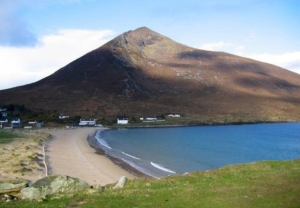
Fortnightly residencies, at the Böll Cottage, provide a secluded and private environment for writers and artists to work, a space where they can escape from their usual routine. In 2002, the Achill Heinrich Böll Association purchased the cottage from the Böll family, to ensure its continued use as an artists’ residence. There is a telephone but no internet.
Achill offers over a dozen restaurants, with fresh Atlantic seafood a speciality, and public houses provide a traditional Irish welcome.
Lodgings will be in a hostel on Achill.
Gallery
Day 5 – The Céide Fields: Moyne Abbey Ruins: Dún Pádraig: Gaelic Ways
Gaelic Ways in Ceathrú Thaidhg
You will be taken on a walk around Ceathrú Thaidhg (the Quarter of the Tadhg family – a noble Gaelic family related to the Kings of Connacht). People whom you will meet come from Irish-speaking homes.
You will experience personal involvement in the activities of local people, demonstrated both on the farm and in the home. They are shown, on the website, in a video called ‘Gaelic Ways’. There are Irish, French, German, English, Persian and Urdhu versions: these are all related Indo-European languages). Some of you may recall such farming ways from your childhood. They are sustainable and eco-friendly. We ourselves have a life-style which is destructive of the environment.
Accomodation/Dinner will, for the final time, be with Irish-speaking families/individuals or with a local German family, which runs a superb hostel. The Irish ‘Céad Míle Fáilte’ – ‘A hundred-thousand Welcomes’ is world-renowned. And nobody can look back to Gaelic Ireland’s historic connections to the French and the Germans quite like those whose culture and civilization are Gaelic.
The Céide Fields – Treasures of the Past
Going along the Atlantic coastline of Mayo, visitors will reach the Céide Fields. This is the greatest stone-age monument anywhere in the World. 250,000 tonnes of stone were used in the construction, now covered by bog.
Excavations have revealed ancient walls and living quarters. They indicate that a farming community lived here, some 5,000 years ago. Radio-carbon dating has been carried out to determine the age of entrapped vegetation, at varying levels. The encroaching bog put an end to this early coastal community, as the climate changed. Fields, which had been enclosed for the purposes of farming, form the oldest such arrangement in Europe.
A University team is doing research into various aspects of the area, which is extensive. Surrounding rocks date from 300-600 million years ago.
Dún Pádraig
Returning to the North Mayo coastline to Dún Padraig (Patrick’s Fort), you will see enormous blowholes, gouged out from the rock face, by crashing waves.
One of these blowholes is situated 300 metres from the coast.
Gaelic Ways in Ceathrú Thaidhg
Finally, you will be taken on a walk around Ceathrú Thaidhg (the Quarter of the Tadhg family – a noble Gaelic family related to the Kings of Connacht). People whom you will meet come from Irish-speaking homes.
You will experience personal involvement in the activities of local people, demonstrated both on the farm and in the home. They are shown, on the website, in a video called ‘Gaelic Ways’. There are Irish, French, German, English, Persian and Urdhu versions: these are all related Indo-European languages). Some of you may recall such farming ways from your childhood. They are sustainable and eco-friendly. We ourselves have a life-style which is destructive of the environment.
Accomodation/Dinner will, for the final time, be with Irish-speaking families/individuals or with a local German family, which runs a superb hostel. The Irish ‘Céad Míle Fáilte’ – ‘A hundred-thousand Welcomes’ is world-renowned. And nobody can look back to Gaelic Ireland’s historic connections to the French and the Germans quite like those whose culture and civilization are Gaelic.
Day 6 – A Train Station with a Story to tell
Kiltimagh Railway Station
The station, which is now out of service, was built in 1894, to link the centre and south of the country. By that time, Gaelic Ireland had been confined to the most remote regions. In this building, however, the memory of the prestigious, blind Gaelic poet, Anthony Raftery, (1784-1835) is celebrated. Also celebrated are the lives and times of Irish construction workers, who were immortalised in the 1960s ballad ‘ McAlpine’s Fusiliers‘. In the ’40s and ’50s, the McAlpine company used to recruit unemployed local men at the Station, on Fair Days, to build roads in England.
The Museum contains a banner from the Land League (a movement for reforming land-ownership). It had been buried for safety in a local bog and had lain there for 40 years. The League was founded in 1879, just after the Famine, in yet another desperate effort to expel the English and return the land to its owners – a basic right under the Brehon Laws (the Gaelic legal system).
The idea of being tenants never agreed with Irish farmers. Even in recent decades, laws were enacted {for example, the Landlord and Tenant (Ground Rents) Act, 2005} to allow remaining Ground Rents to be bought out.











